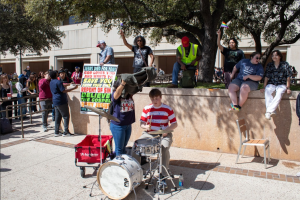Greg Abbott doesn’t care about homeless people
Co Opinion Editor Dawson Fagan
January 21, 2020
Texas Gov. Greg Abbott loves to criminalize homelessness, and he (rightly) catches a lot of condemnation for that. However, Gov. Abbott also loves the way San Antonio deals with its homeless population. What does that say about us?
Gov. Abbott regularly attributes crimes to homeless individuals without any evidence, as he did recently with the Woodburn stabbing in Austin and last August when he tweeted, “Look at this insanity caused by Austin’s reckless homeless policy.” The “insanity” was a car accident that the Austin Police Department stated was unrelated to homelessness or pedestrians.
Gov. Abbott has also praised San Antonio’s handling of homelessness, saying, “Probably the best template for this is a strategy that’s been developed in San Antonio.”
The problem is San Antonio’s homeless population hasn’t substantially decreased since 2010. Instead, the homeless population in San Antonio has just moved from downtown to Haven for Hope, which does not follow a Housing First model, a homelessness triage philosophy that quickly and automatically connects victims of homelessness to permanent housing, without barriers such as sobriety.
From 2011 to 2019, the San Antonio homeless population shrunk by almost 11%, from 3,222 to 2,872, according to local organization South Alamo Regional Alliance for the Homeless. However, according to the same point-in-time (PIT) studies, the prevalence of homeless families went up by 18% from 2018 to 2019. This last data point is likely the result of an increase in housing costs and a stagnant wage trend.
The point is this: 350 fewer victims of homelessness over eight years is not exactly a feat, especially considering the number of homeless families has gone up.
So, how is San Antonio the ideal model? Recognizing that San Antonio is the perfect model only for Gov. Abbott is essential. Gov. Abbott likes what San Antonio has done for its homeless population because we just moved these people out of downtown, instead of into homes.
Houston homelessness has gone down by 54% since 2011, according to the latest PIT report, and that decrease is the result of permanent, affordable housing.
To quote Andy Icken, Houston’s Chief Development Officer, “The solution to homelessness is a home.”
According to Icken, this principle inspired the Houston Housing Authority to focus on permanent housing for victims of homelessness.
The Housing First principle prevents homeless individuals from bouncing from shelter to shelter. This strategy is how Houston went from a homeless population of 8,538 in 2011 to just over 3,900 in 2019.
To authentically fight for the homeless, San Antonio must develop affordable, permanent housing. However, according to Apartment List, an online rent aggregator site, rent in San Antonio has gone up 16.5% from 2008 to 2018. During that same time, average renter wages increased by only 3.5%.
This lack of wage growth, according to the U.S. Census Bureau, is what led to San Antonio’s poverty rate of 20% in 2018, topping the list for the highest poverty rate of any large metropolitan area in the country.
So, following Gov. Abbott’s remarks and San Antonio’s pride in how it deals with its homeless population, the perfect model is one of increasing poverty, decreasing affordable housing, and a constant homeless population.
The Department of Housing and Urban Development requires cities to do a homelessness PIT report during the last 10 days of January, every year. Remember these trends, and see if Houston surprises or if San Antonio takes a cue.









Albert Logan Jr • Feb 6, 2020 at 1:56 pm
I think the answer to homelessness is not homes. 92% of homeless people are drug and alcohol addicts that need help with there problems so they can live a productive life. Simply giving them a home will not solve this issue. Granted there are people who are trying to live a productive life who are just in a bad spot and need housing, therefore this should be temporary until they can get on there feet. i feel San Antonio needs a program to rehabilitate people so they can live productive lives, and as long as they are enrolled and participating only than should they be given government housing. If there is no way to fix the drug, alcohol, and help the mentally ill, simply giving them free housing would turn into slums. Look at Rhode island, they have a system helping people in need and it seems to be working pretty good. They also help rehabilitate convicts coming out of prison to help them when they get out to live productively and to keep them from going back to crime. I believe the program is called MAT(medication assisted treatment) and CODAC(behavioral healthcare system). This is something that homeless people with drug and alcohol issues can benefit from ,along with the thousands of convicts it helps today.